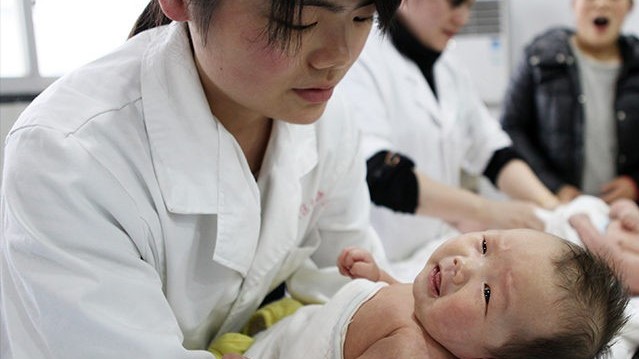The top Chinese health official in charge of population monitoring on Friday called for “bold” action to reverse China’s population decline, specifically including programs to reduce the cost of childbirth so Chinese families will begin having more babies.
“Local governments should be encouraged to actively explore and make bold innovations in reducing the cost of childbirth, childcare and education,” Yang Wenzhuang, director of Population Monitoring and Family Development at the Chinese National Health Commission (NHC), said in a statement carried by state media.
Yang asserted that one major reason for China’s increasingly troubling population decline is that women are more concerned with finances and careers, and they are keenly aware that having children is expensive. He urged the Chinese government to include corrective programs in its current five-year plan, which extends until 2025, which is another way of saying there is no time to lose.
The Chinese Communist government admitted to its first net population decline since 1962 in January, posting about 850,000 deaths in excess of births nationwide.
Many outside experts believe the Chinese population is declining more steeply than the regime in Beijing wants to admit, with net losses beginning as early as 2020 and births falling below the generally accepted replacement rate of 2.1 children per woman even before that.
Chinese state media tried to spin the net loss reported in January as a positive development, a cheerful sign that more women are entering the workforce as the sluggish economy pulls out of its pandemic lockdown-induced doldrums, but Yang certainly does not seem to think it is good news if he is recommending emergency action on a massive scale.
The regime is reluctant to admit its horrific “One Child” policy of population control, forced abortion, and infanticide created its current demographic crisis, but outside analysts are more open about the role it played, especially since One Child was exceptionally rough on baby girls. Chinese families forced by their tyrannical government to have only one child tended to prefer boys, so female children were often aborted or outright murdered after birth.
The resulting shortage of fertile young women today makes the already difficult demographic issue facing most of the industrialized world even more challenging for China. No other government has come up with a good solution for the core problem of young people choosing to skip or delay pregnancy to focus on careers and income. Some, such as Japan, have slipped further down the demographic pit than China.
Japanese Prime Minister Kishida Fumio declared a demographic emergency in late January, warning that his country is “on the cusp of whether it can maintain its societal functions.”
“It is an issue that simply cannot wait any longer,” Kishida said, proposing a dramatic increase in the budget for children’s issues and creating a new agency to help families cope with the high cost of childrearing.
Raising children is even more expensive in China, relative to income, and China already has an agency for family issues, which Yang Wenzhuang directs. China rescinded the One Child Policy in 2016, expanding it first to two children per family and then three in 2021. Chinese bureaucrats should have realized much sooner that allowing two children per family is not good enough – reaching and exceeding the fertility rate of 2.1 children per woman requires a large number of families with three or more kids, to cover for those who never have any.
China not only permitted more children for each woman; it strongly encouraged them to be fruitful and multiply. Some Chinese state media commentators have come close to suggesting women should be ordered to have more children.
Yang’s suggestion that children are too expensive so the government should subsidize them is nothing new. Chinese officials and citizens have been citing the financial burdens of raising a family ever since the One Child Policy was relaxed in 2016. Provincial governments have proposed financial assistance programs, such as one full year of paid maternity leave. To date, none of these measures have arrested China’s demographic decline.
Part of the problem might be that merely deferring the high cost of birthing and parenting does not fully compensate for what upwardly mobile young couples see as the full burden of raising a child.
Chinese parents interviewed by Agence France-Presse (AFP) in January said that in China’s high-stress cutthroat corporate world, even a full year of paid maternity leave would not compensate a mother for the damage to her career from raising a child. Many of China’s largest cities, including the capital of Beijing, already offer a third of a year in paid leave, without much impact on low fertility rates.
“I can’t balance it all,” one young mother in Beijing told AFP. “If you want to breastfeed the child then you basically have to give up work, but because of our situation, we cannot give up our jobs.”
Another problem is that China’s pattern of young people migrating to cities to pursue their careers leaves grandparents out of the loop. Chinese women who are able to rely on their parents for help said they were fortunate to have resources many other working mothers lack, although they felt guilty about leaning on their own parents so hard and are resentful of their authoritarian government for forcing them to do so.
“No matter how much the government gives me or if they offer a better environment, I wouldn’t choose to have more kids. It’s not something that can be solved financially,” the Beijing mom told AFP, bluntly refuting Yang Wenzhuang’s proposals for emergency measures to pull China out of its demographic death spiral.


